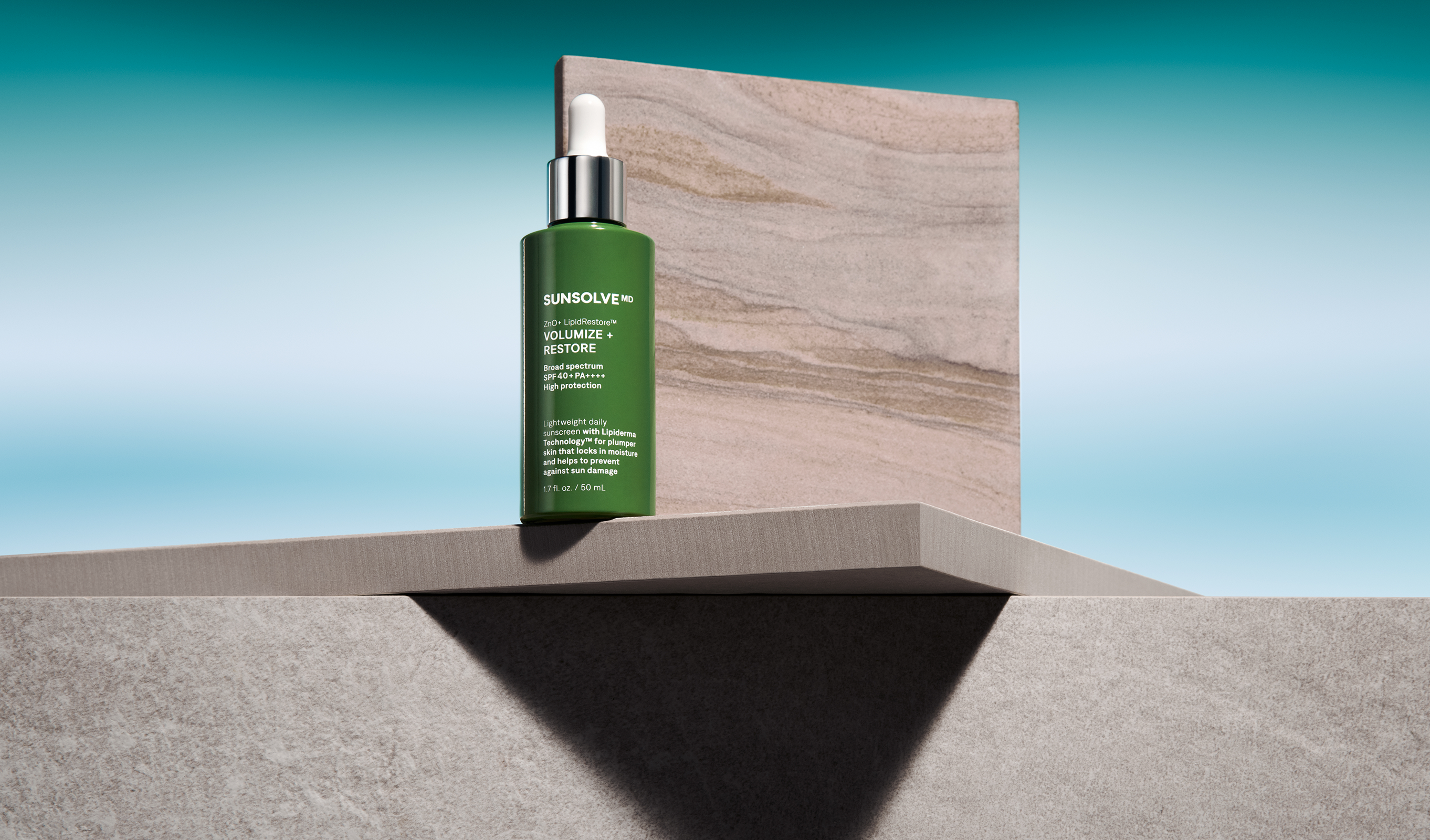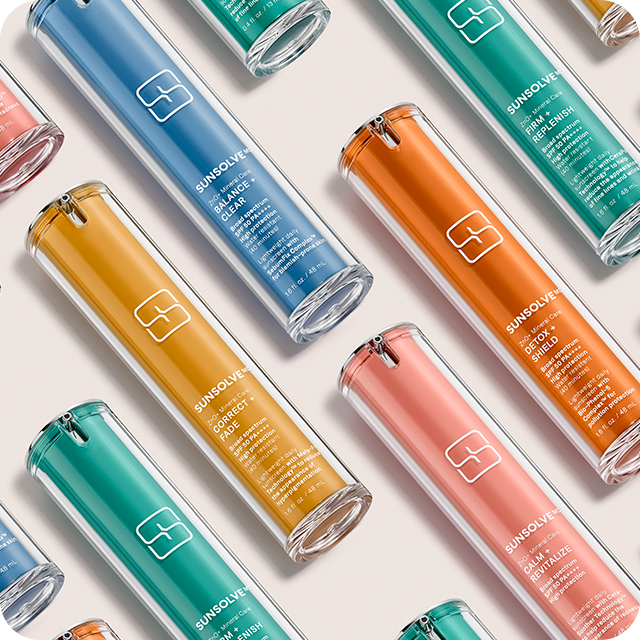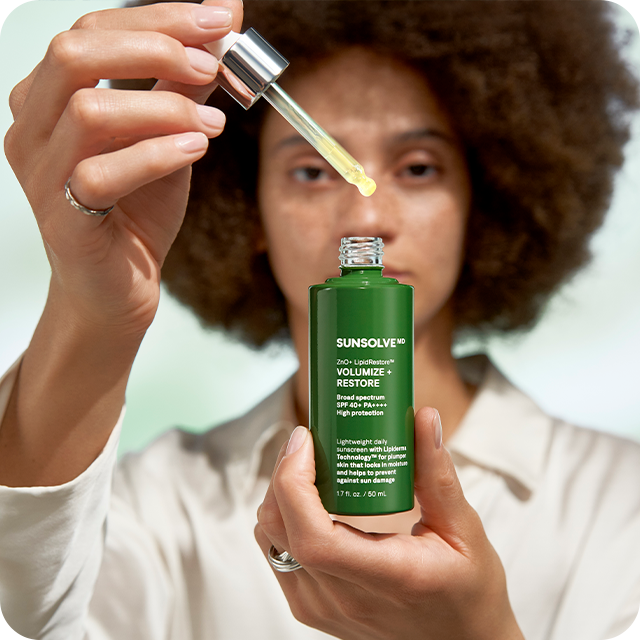1. “The SPF in my foundation is enough, right?”
Wrong. While makeup with added SPF can offer some protection (typically only against UVB rays), it’s highly unlikely that you’re using enough product to get the labeled protection. You need to apply half a teaspoon’s worth to your face and neck for full protection, which is far more foundation than you’d actually need. For this reason, it’s always best to use a dedicated sunscreen underneath your makeup to ensure you’re properly protected.
Looking for a sunscreen that can also double up as a skin tint and moisturizer? Discover our AntiOxtint range — our collection of antioxidant-rich tinted SPF formulas.
2. “Mineral sunscreen isn’t made of chemicals.”
The word mineral might sound more natural, but in actuality both mineral and chemical sunscreens are made up of chemicals. Everything is. There is an outdated myth that mineral sunscreen reflects UV while chemical absorbs it, but the truth is, both absorb, with mineral filters also reflecting a small amount of UV rays.
3. “I only need sunscreen in the summer or when it’s sunny.”
UVA and UVB rays are present year-round and can pass through clouds and windows. If it’s daylight, UV is present. While UV exposure is typically greater in the summer, temperature isn’t an indicator of its strength. In fact, UV exposure can intensify in snowy environments due to reflection from the snow’s surface.
4. “Darker skin doesn’t need sunscreen.”
Research shows that Black is vulnerable to the same sun damage that affects all skin tones — including skin cancer, premature aging, and hyperpigmentation, which is especially common in deeper skin tones.
5. “Sunscreen stops your body from making vitamin D.”
Most people create sufficient vitamin D from incidental sun exposure, like walking outdoors or sitting by a window, so you don’t need to worry. Plus, no sunscreen blocks 100% of UV radiation. You can also get vitamin D through diet and supplements, widely recommended in the winter months when daylight is limited.
6. “Layering multiple products with sunscreen will increase my SPF protection.”
SPF values are not additive, nor linear. For example, applying a foundation with SPF 15 and a moisturizer with SPF 30 will not give you SPF 45.
7. “The higher the SPF, the thicker the texture.”
SPF level doesn’t dictate texture, the formula does. This misconception comes from the fact that mineral sunscreens can often leave a heavier white cast as the protection level increases. Thus making it more visible and chalky.
At SunsolveMD, we use a patented ZnO+ Complex™, which contains ultra-thin micronized zinc oxide with an elegant, blendable texture, helping to make it more inclusive across a wide range of skin tones.

8. “Wearing SPF 50 means I’ll be protected all day.”
No sunscreen can truly offer all-day protection from a single application.
The SPF value indicates how much longer you can stay in the sun without burning compared to unprotected skin. For example, if you’d normally burn after 10 minutes, an SPF 50 would give you 500 minutes worth of protection under ideal conditions.
But in reality, sunscreen needs to form a continuous, even film over the skin to be effective. This layer is easily disrupted by sweat, oil, fabric transfer and face-touching. That’s why all sunscreens need to be reapplied every two hours for effective protection, or more frequently if you’re swimming or sweating.
9. “I don’t need to wear sunscreen indoors.”
There is a bit of truth here: if you’re indoors all day in a room with no windows or you’re away from natural light, sunscreen isn’t essential. However, if you’re sitting near a window or skylight, you will be exposed to UV radiation (remember, UVA rays can penetrate through glass), making sunscreen essential to protect your skin.
10. “ I don’t burn, so I don’t need sunscreen.”
Sunburn isn’t the only sign of skin damage. Even if you don’t burn easily, UV rays can still age your skin, cause hyperpigmentation and inflammation, and increase your risk of skin cancer, making sunscreen necessary for all.
Keep your skin protected with SunsolveMD: where next-generation sun protection meets results-driven skincare.

References
Tsai J, Chien AL. Photoprotection for Skin of Color. Am J Clin Dermatol. 2022 Mar;23(2):195-205. doi: 10.1007/s40257-021-00670-z. Epub 2022 Jan 19. PMID: 35044638; PMCID: PMC8766623.






